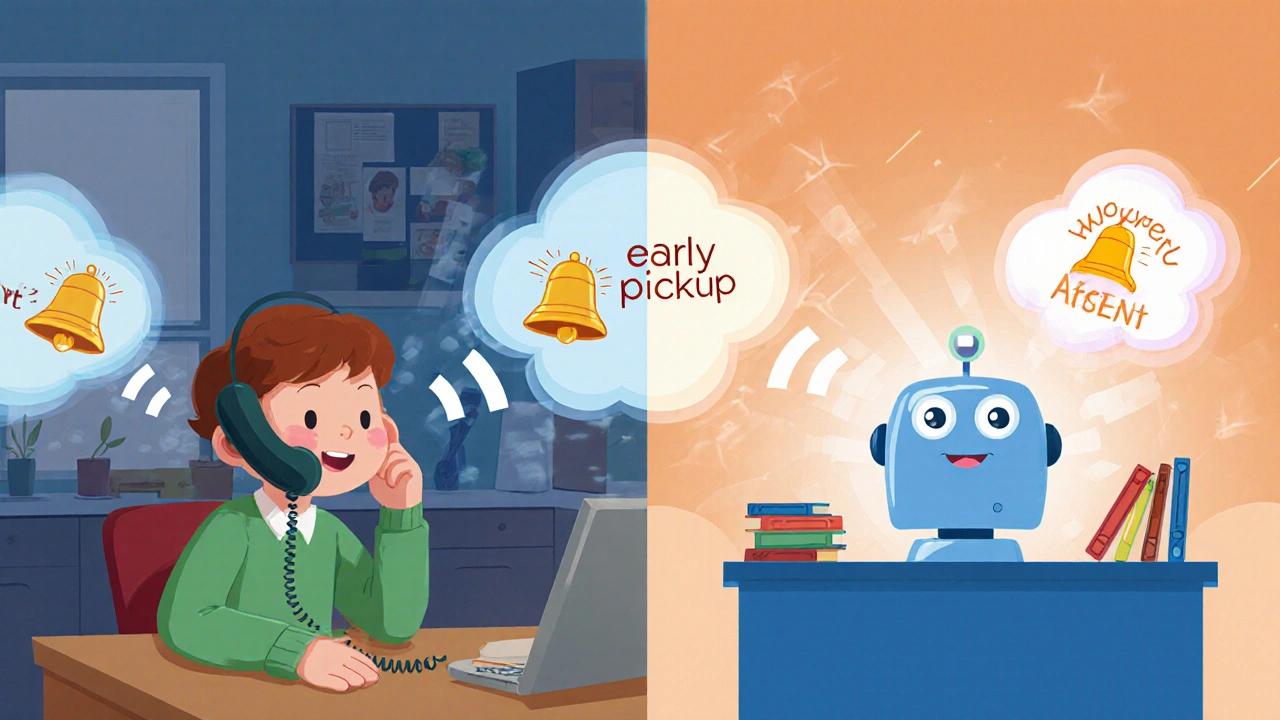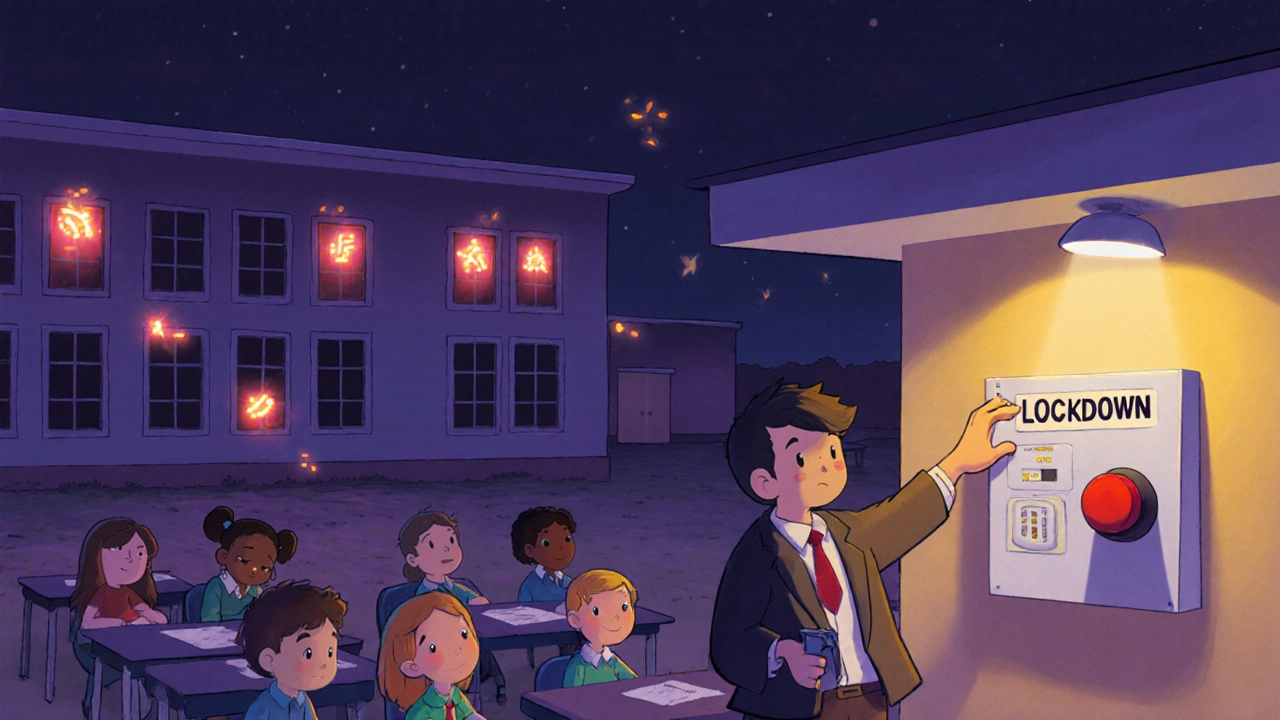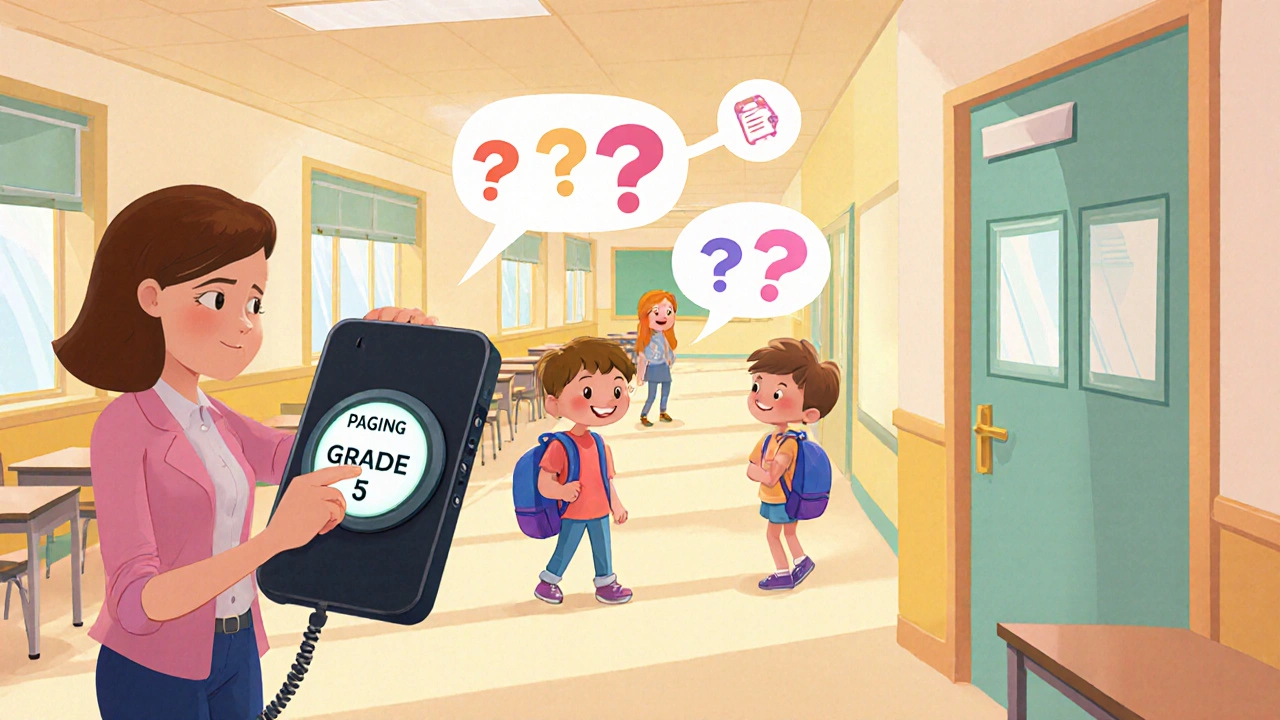Imagine a school bell rings, but no one hears it. A parent calls about a sick child, but the front office is swamped. A fire drill starts, and half the classrooms don’t get the message. These aren’t hypotheticals-they’re real problems schools faced before VoIP. Today, more than 42% of U.S. public school districts and 68% of private schools use Voice over Internet Protocol systems to fix these issues. It’s not just about cheaper phone bills. It’s about saving time, reducing panic, and keeping kids safe.
Why Schools Are Switching from Old Phones to VoIP
For decades, schools relied on analog phone systems and wired intercoms. They worked fine-until they didn’t. A broken line meant no calls. A broken speaker meant no announcements. And if a parent called during drop-off chaos, they’d often get stuck in a loop of voicemails and transfer menus. VoIP changes that. Instead of copper wires, it uses the school’s internet to send voice data. That means one network does everything: phones, intercoms, emergency alerts, even video calls. The shift started in earnest around 2015, when broadband became reliable enough to handle voice traffic without lag or dropped calls. Today, systems from Grandstream, Yealink, and RingCentral are built specifically for schools-not businesses. The biggest win? Speed. Emergency alerts that used to take 90 seconds to broadcast across a campus now take under a minute. Parent calls that once took 3-5 minutes to route now connect in two rings or less. That’s not a minor upgrade. It’s a lifesaver.How Parent Hotlines Work in Real Schools
Parent hotlines aren’t just a single number that rings the front desk. They’re smart, automated systems designed around how parents actually call. At 7:15 a.m., the flood begins. Parents need to know if school is delayed. They’re asking about bus routes. They’re reporting a child’s absence. By 3:00 p.m., it’s pickup questions, after-school changes, and permission slips. VoIP systems recognize these patterns. They route calls based on time of day and keyword detection. Here’s how it works in practice:- A parent calls the main number: "I need to pick up my son early today."
- The system uses voice recognition to detect keywords like "early pickup" or "absent."
- It routes the call to the attendance office-not the principal, not the nurse, not a voicemail.
- If it’s after hours, the message is transcribed to email and sent to the student’s teacher.
Classroom Paging: From Shouting Down the Hall to One Button
Before VoIP, paging meant shouting into a microphone or hitting a big red button that blasted sound to every room. That’s fine for fire alarms. Not for a quiet reading class, or a student with sensory issues. Modern IP-based classroom paging lets staff send messages to single rooms, entire grades, or zones-like "all third-floor classrooms" or "cafeteria only." It’s done through programmable buttons on desk phones or wall-mounted panels. No shouting. No disruption. Grandstream DP750 and Yealink T55A phones are common in classrooms. They have dedicated buttons labeled "Paging - Grade 5" or "All Classrooms." A teacher presses one, says, "Please report to the office," and the message plays quietly in that room through the speaker. No one else hears it. The real power shows during emergencies. In a lockdown, a single button press can alert every classroom simultaneously. According to GetVoIP’s 2022 study, this cuts lockdown initiation time by 22 seconds on average. In a real crisis, seconds matter. One high school principal on Reddit shared that their emergency drills dropped from 3 minutes to 47 seconds after switching to VoIP paging. "But we lost our entire system during a power outage," they added. "That’s when we installed battery backups. Now we’re ready."
What You Need to Make It Work
VoIP isn’t plug-and-play. Schools that skip the prep end up with echo, dropped calls, or systems that go silent during outages. Here’s what’s required:- Internet speed: At least 25 Mbps upload and download per 100 users. Many schools think 10 Mbps is enough. It’s not. During peak hours, voice traffic needs room to breathe.
- Network hardware: Gigabit routers like Cisco RV340, CAT6 cabling, and switches with Quality of Service (QoS) turned on. QoS makes sure voice calls get priority over YouTube or Zoom.
- Power backup: Battery backups for IP phones and network gear. Without this, a 10-minute outage can disable your entire paging system.
- Security: End-to-end encryption, multi-factor login for admins, and regular audits. FERPA violations can happen if parent calls with student info are intercepted. 92% of districts now meet CNSS Instruction No. 5000 standards-but the other 8% are at risk.
Costs, Providers, and What You Get for Your Money
VoIP systems cost more upfront than analog ones. But they save money long-term.- Per classroom cost: $1,200-$3,500, depending on phone model and features.
- Monthly service: $18.50-$32.75 per user. This covers phones, hotlines, paging, and cloud support.
- Hardware leaders: Grandstream (41% market share), Yealink (29%), Cisco (18%).
- Service providers: RingCentral (38%), 8x8 (27%), Nextiva (19%).

The Hidden Risks and How to Avoid Them
VoIP isn’t magic. It has downsides.- Network dependency: 28% of schools still experience paging failures during outages. Solution: Battery backups and cellular failover systems.
- Staff training: 35% of teachers struggled at first. Solution: Involve them early. One study found 63% higher satisfaction when teachers helped design the call routing.
- Over-automation: The National Education Association warns that too many automated hotlines reduce real human contact. Parents want to talk to a person sometimes. Keep an option for live transfer.
- Accessibility: 71% of systems now include visual paging lights for hearing-impaired staff. If yours doesn’t, you’re not compliant with ADA.
What’s Next for School VoIP?
The future is here. Schools are already testing:- AI-powered hotlines: Systems that learn from past calls. If 80% of 7:30 a.m. calls are about bus delays, the system starts with that option.
- Mobile paging: Teachers get alerts on their phones-even when they’re off campus. Useful for last-minute changes.
- Integration with student systems: VoIP connected to PowerSchool or Infinite Campus. If a student is marked absent, the system auto-notifies parents.
- Voice-activated emergencies: "Lockdown, all classrooms" spoken into a phone triggers the alert. No button needed.
Final Thought: It’s Not About Technology. It’s About Trust.
Parents don’t care if your system uses SIP or H.323. They care that when they call, someone answers. That when their child is in danger, the whole school hears the alert. That when the system fails, you have a backup. VoIP isn’t just a phone upgrade. It’s a promise to families: We’ve got you. We’re ready. We’re listening.Can VoIP work in a school with slow internet?
Not reliably. VoIP needs at least 25 Mbps upload and download per 100 users. If your internet is slower, you’ll get choppy calls, dropped messages, and paging failures during peak times. Many schools fail because they skip a proper network assessment. Test your speed during school hours-not at night. If you’re under 25 Mbps, upgrade your connection before installing VoIP.
Do we need new phones for VoIP?
Yes. Analog phones won’t work with VoIP. You need IP phones with Ethernet ports-models like Grandstream DP750 or Yealink T55A. These have programmable buttons for classroom paging and support encryption. You can reuse existing desk phones only if they’re already IP-enabled, which is rare in older schools.
Is VoIP secure for parent calls with student info?
Only if configured correctly. FERPA requires all communications with student data to be encrypted. Make sure your system uses end-to-end encryption, requires multi-factor authentication for admin access, and logs all calls. Avoid providers that don’t comply with CNSS Instruction No. 5000. Many schools have faced fines for unencrypted calls.
How long does it take to install a VoIP system?
For a medium-sized district (5,000-15,000 students), plan for 12-16 weeks. Network assessment takes 2-3 weeks. Hardware installation takes 3-4 weeks. Parent hotline setup and staff training take another 2-3 weeks. Testing and tweaks add 2-4 weeks. Rushing leads to failures. A phased rollout-starting with one building-is safer.
Can teachers use VoIP from home?
Yes, if your provider offers a mobile app. Teachers can receive classroom paging alerts, take parent calls, and send announcements from their smartphones. This is useful for last-minute changes, sick calls, or emergency notifications when they’re off-site. But make sure the app is encrypted and requires login credentials-don’t let personal devices become security risks.
What’s the biggest mistake schools make with VoIP?
Trying to do everything at once. Schools often install phones, hotlines, paging, and integration with student systems all in one go. That’s a recipe for chaos. Start with one goal: fix emergency paging. Then add the parent hotline. Then connect to your student database. Each step needs testing, feedback, and training. Slow wins the race.
